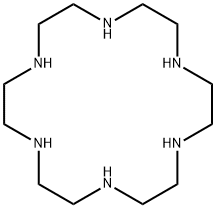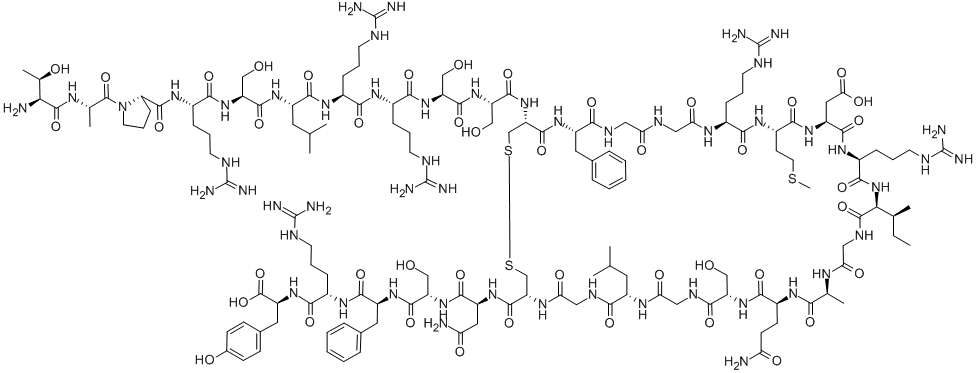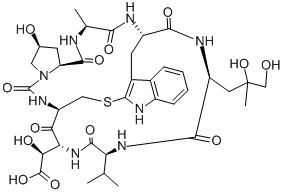PENTAETHYLENEHEXAMINE
Synonym(s):3,6,9,12-Tetraazatetradecane-1,14-diamine;Pentaethylenehexamine
- CAS NO.:4067-16-7
- Empirical Formula: C10H28N6
- Molecular Weight: 232.37
- MDL number: MFCD00008167
- EINECS: 223-775-9
- SAFETY DATA SHEET (SDS)
- Update Date: 2025-09-25 17:15:13

What is PENTAETHYLENEHEXAMINE?
Chemical properties
dark yellow-green liquid
The Uses of PENTAETHYLENEHEXAMINE
5.Pentaethylenehexamine has been used in the preparation of:
- polyisobutylene succinimide (PIBSI) dispersants, used as engine oil-additives
- poly(glycidyl methacrylate) (P(GMA)) homopolymers
- poly(amidoamine)s
What are the applications of Application
Pentaethylenehexamine is a versatile polyamine synthesis reagent
General Description
Yellowish liquid with an odor of ammonia.
Air & Water Reactions
Water soluble.
Reactivity Profile
PENTAETHYLENEHEXAMINE neutralizes acids in exothermic reactions to form salts plus water. May be incompatible with isocyanates, halogenated organics, peroxides, phenols (acidic), epoxides, anhydrides, and acid halides. Flammable gaseous hydrogen may be generated in combination with strong reducing agents, such as hydrides.
Health Hazard
Contact with eyes can cause slight to moderate irritation and possible burns. May cause transient fogging of the eyes as a result of corneal edema, which is reversible. May cause moderate skin irritation or allergic skin reaction with symptoms of redness, itching, swelling, or rash. Vapors may irritate the eyes, nose, throat, and respiratory tract. May cause coughing, headache, nausea and vomiting. If swallowed, may cause nausea, vomiting and abdominal pain. May cause burns of the mouth, throat, esophagus, and stomach.
Safety Profile
Moderately toxic by ingestion. Mutation data reported. Whenheated to decomposition it emits toxic fumes of NOx.
Purification Methods
Fractionally distil it twice at 10-20mm, the fraction boiling at 220-250o being collected. It can be further purified via the hydrochloride. Its solution in MeOH (40mL of base in 250mL) is cooled in an ice-bath and conc HCl (~50mL) is added dropwise with stirring. The precipitated hydrochloride is filtered off, washed with Me2CO, and Et2O, then dried in a vacuum desiccator. The free base is then obtained by basification, extraction into Et2O, drying (NaOH), filtering, evaporating and distilling the residue as before. It forms a Cu complex [Cu(C10H28N6)]2+. [Jonassen et al. J Am Chem Soc 79 4279 1957, Beilstein 4 IV 1245.]
Properties of PENTAETHYLENEHEXAMINE
| Melting point: | -35 °C |
| Boiling point: | 380 °C |
| Density | 0.95 g/mL at 25 °C (lit.) |
| vapor pressure | <1 hPa (20 °C) |
| refractive index | n |
| Flash point: | >230 °F |
| storage temp. | Store below +30°C. |
| solubility | water: soluble500g/L at 20°C |
| form | Liquid |
| pka | 10.07±0.19(Predicted) |
| color | Clear yellow |
| PH | 11 (10g/l, H2O) |
| BRN | 1768042 |
| Stability: | Stable. Incompatible with strong oxidizing agents, strong acids. |
| CAS DataBase Reference | 4067-16-7(CAS DataBase Reference) |
| EPA Substance Registry System | Pentaethylenehexamine (4067-16-7) |
Safety information for PENTAETHYLENEHEXAMINE
| Signal word | Danger |
| Pictogram(s) |
 Corrosion Corrosives GHS05  Exclamation Mark Irritant GHS07  Environment GHS09 |
| GHS Hazard Statements |
H314:Skin corrosion/irritation H317:Sensitisation, Skin H410:Hazardous to the aquatic environment, long-term hazard |
| Precautionary Statement Codes |
P261:Avoid breathing dust/fume/gas/mist/vapours/spray. P272:Contaminated work clothing should not be allowed out of the workplace. P273:Avoid release to the environment. P280:Wear protective gloves/protective clothing/eye protection/face protection. P303+P361+P353:IF ON SKIN (or hair): Remove/Take off Immediately all contaminated clothing. Rinse SKIN with water/shower. P305+P351+P338:IF IN EYES: Rinse cautiously with water for several minutes. Remove contact lenses, if present and easy to do. Continuerinsing. |
Computed Descriptors for PENTAETHYLENEHEXAMINE
PENTAETHYLENEHEXAMINE manufacturer
New Products
4,4-Difluoropiperidine hydrochloride tert-butyl 9-methoxy-3-azaspiro[5.5]undecane-3-carboxylate Indole Methyl Resin N-Isopropylurea N,N-Dicyclohexylcarbodiimide(DCC) MELDRUMS ACID 5-METHYLISOXAZOLE-4-CARBOXYLIC ACID Magnessium Bis glycinate Zinc ascorbate 1-bromo-2-butyne 2-acetamidophenol 9(10H)-anthracenone Erythrosin B, 4-Piperidinopiperidine 2-((4-morpholinophenylamino) (methylthio) methylene) malononitrile 2,4-dihydroxybenzaldehyde 3-(4-morpholinophenylamino)-5-amino-1H-pyrazole-4-carbonitrile Methyl 2-methylquinoline-6-carboxylate 2,6-dichloro-4-nitropyridine 4-Bromo-2-chlorobenzonitrile 2-(benzylamino)acetic acid hydrochloride 4-(tert-Butoxycarbonylamino)but- 2-ynoic acid 3,4-dihydro-2H-benzo[b][1,4]dioxepine 1-Phenyl-1-cycloprppanecarboxylicacidRelated products of tetrahydrofuran








You may like
-
 Pentaethylenehexamine, 70% CAS 4067-16-7View Details
Pentaethylenehexamine, 70% CAS 4067-16-7View Details
4067-16-7 -
 Pentaethylenehexamine (mixture) CAS 4067-16-7View Details
Pentaethylenehexamine (mixture) CAS 4067-16-7View Details
4067-16-7 -
 Pentaethylenehexamine CAS 4067-16-7View Details
Pentaethylenehexamine CAS 4067-16-7View Details
4067-16-7 -
 Pentaethylenehexamine CAS 4067-16-7View Details
Pentaethylenehexamine CAS 4067-16-7View Details
4067-16-7 -
 3-(4-amino-1-oxoisoindolin-2-yl)-1-methylpiperidine-2,6-dione 98%View Details
3-(4-amino-1-oxoisoindolin-2-yl)-1-methylpiperidine-2,6-dione 98%View Details -
 20677-73-0 (2,2-diethoxyethyl)methylamine 98%View Details
20677-73-0 (2,2-diethoxyethyl)methylamine 98%View Details
20677-73-0 -
 3-(4-(hydroxyamino)-1-oxoisoindolin-2-yl)piperidine-2,6-dione 98%View Details
3-(4-(hydroxyamino)-1-oxoisoindolin-2-yl)piperidine-2,6-dione 98%View Details -
 57381-49-4 2-bromo-4-chlorobenzonitrile 98%View Details
57381-49-4 2-bromo-4-chlorobenzonitrile 98%View Details
57381-49-4
